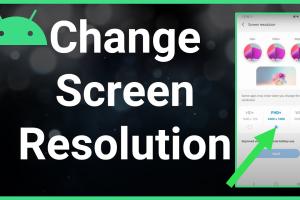Mastering Android: A Comprehensive Guide to Changing Screen Resolution

-
Quick Links:
- Introduction
- Understanding Screen Resolution
- Why Change Screen Resolution?
- How to Change Screen Resolution on Android
- Device-Specific Methods
- Common Issues and Solutions
- Expert Insights
- Case Studies
- Conclusion
- FAQs
Introduction
In the modern digital age, our smartphones have become an integral part of our lives. Android devices, with their diverse functionalities and personalization options, are particularly popular. One such personalization option is the ability to change the screen resolution. Whether you're looking to enhance your viewing experience or troubleshoot display issues, understanding how to change the screen resolution on your Android device is essential.
Understanding Screen Resolution
Screen resolution refers to the number of pixels displayed on the screen. It is usually denoted in width x height format (e.g., 1920x1080). A higher resolution means more pixels, which generally results in better image quality and clarity. Different Android devices support various resolutions based on their specifications.
Common Screen Resolutions
- HD (1280x720)
- Full HD (1920x1080)
- Quad HD (2560x1440)
- Ultra HD (3840x2160)
Why Change Screen Resolution?
There are several reasons you might want to change your Android device's screen resolution:
- Improve Battery Life: Lowering the resolution can help conserve battery power.
- Enhance Performance: For gaming or heavy applications, reducing the resolution might improve performance.
- Personal Preference: Some users prefer a specific resolution for better visibility or aesthetics.
How to Change Screen Resolution on Android
Changing the screen resolution can vary depending on your device and version of Android. Below are general steps you can follow to adjust screen resolution:
Step-by-Step Guide
- Open Settings on your Android device.
- Scroll down and tap on Display.
- Look for Screen Resolution or Screen Size options.
- Select your preferred resolution from the available options.
- Confirm your choice and restart your device if prompted.
Device-Specific Methods
Different manufacturers often have varied methods for changing the screen resolution. Here are some device-specific guides:
Samsung Devices
For Samsung devices, the resolution can be adjusted by:
- Go to Settings.
- Select Display.
- Tap on Screen Resolution.
- Choose the desired resolution and apply changes.
Xiaomi Devices
Xiaomi follows a slightly different path:
- Open Settings.
- Select Display and then Full-Screen Display.
- Adjust the resolution settings from there.
Common Issues and Solutions
When changing the screen resolution, users may encounter several common issues:
Screen Flickering
If you experience screen flickering after changing the resolution, revert to the previous setting and try a different resolution.
Performance Issues
Lowering the resolution can help alleviate performance issues during intensive tasks or gaming.
Expert Insights
Experts recommend regularly adjusting your screen resolution based on your activities. For instance, high-resolution settings are optimal for watching videos, while lower settings can enhance gaming performance.
Case Studies
In a study conducted by TechRadar, users who adjusted their screen resolutions reported a 20% increase in battery life when switching to a lower resolution during prolonged use.
Conclusion
Changing the screen resolution on your Android device is a valuable skill that can enhance your user experience. Whether it's for better visibility, performance, or battery conservation, knowing how to adjust these settings will allow you to customize your device to your liking.
FAQs
1. Can I change the screen resolution on all Android devices?
Not all Android devices allow screen resolution changes. Check your device settings to see if this option is available.
2. Will changing the resolution void my warranty?
No, changing screen resolution does not void your warranty as it is a standard feature in Android settings.
3. How can I reset to default resolution?
You can usually reset to default settings in the same display settings menu where you adjusted the resolution.
4. Does changing resolution affect app performance?
Yes, changing the resolution can improve app performance, especially in gaming or graphic-intensive applications.
5. Can low resolution cause display issues?
Using a low resolution can sometimes cause blurriness in visuals, particularly on larger screens.
6. How do I know my device's max resolution?
You can find this information in your device specifications or in the display settings under resolution options.
7. Is there a way to change resolution using third-party apps?
Yes, some third-party apps available on the Play Store can help change screen resolution, but they may require rooting your device.
8. How often should I change screen resolution?
It depends on your usage. You may want to adjust settings based on your current activity, such as gaming or video watching.
9. Can I change resolution without rooting my device?
Yes, most devices allow resolution changes without rooting, through the device settings.
10. Will changing resolution affect battery life?
Lowering the resolution can help conserve battery life, while higher resolutions may drain the battery faster.
For further reading and in-depth analysis, you may refer to the following resources:
Random Reads
- How to center an image in html
- How to change a bag on a vacuum cleaner
- Effective strategies to eliminate and hide smoke smell indoors
- How to catch zapdos in pokemon yellow
- How to get rid of unread email badge gmail app
- Fix roblox error 268
- Fix keyboard wrong characters
- How to calculate confidence interval
- How to repair wall cracks
- How to repair vinyl flooring